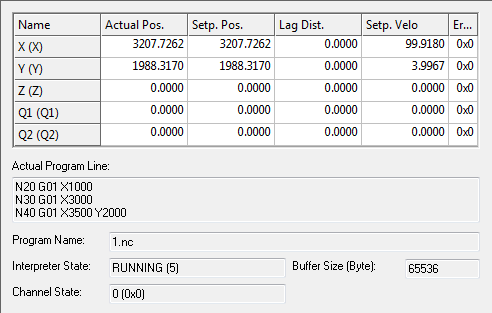Interpreter online window

Axes
As on the "Online" properties page in the interpolation channel, this window lists all axes currently included in the interpolation group. Values for the following parameters are displayed:
- Actual positions
- Set positions
- Following errors
- Set velocities and
- Current error codes
.
Actual Program Line
The Actual Program Line shows the current NC block to be processed in the block execution. The last row in the window is the current block.
Unlike this, the current block is in the middle row in the case of GST.
As for nearly all the parameters, the program display can be read off via ADS. This can be used to display the current NC blocks in a Visual Basic application, for example (see ADS device documentation - ADS Interface NC).
Program name
Displays the name of the currently loaded program. This does not necessarily have to be the program displayed in Editor.
Interpreter status
The interpreter status indicates the current status of the interpreter state machine. The complete list is given below. As PLC evaluation does not require all status information, only the most important parameters are explained.
Status | Description |
|---|---|
ITP_STATE_IDLE | The interpreter is in idle state when there is no NC program loaded as yet or when a group reset is being executed. The interpreter also goes into idle state when a current program is stopped. In the case a group reset must be executed in order to prevent error 0x42C5. It is therefore recommended to execute a group reset after stopping via the PLC. |
ITP_STATE_READY | After successful loading of an NC program, the interpreter is in ready state. After a program has been successfully processed and exited, the interpreter goes into ready state. In the meantime, however, other states are accepted. |
ITP_STATE_ABORTED | If a runtime error occurs during the processing of an NC program, the interpreter goes into aborted state. The actual error code is given in the channel status. |
ITP_STATE_SINGLESTOP | This status is only accepted in Single Block Mode. As soon as the entry has been sent from the interpreter to the NC core, the interpreter goes into this mode. |
 | Querying the interpreter status during program execution Since the interpreter status may change between different states during program execution, we recommend querying it with a negative logic. During program execution the interpreter state is not necessarily ITP_STATE_RUNNING. If the program was executed successfully, the interpreter is subsequently always in Ready state (see also Samples). |
 | End of program The end of the program is characterized by an M function. Therefore either M2 or M30 are being used. If the M function is missing at the end of the program, the status of the interpreter could return wrong values. |
Interpreter status return values
0 ITP_STATE_INITFAILED
1 ITP_STATE_IDLE
2 ITP_STATE_READY
3 ITP_STATE_STARTED
4 ITP_STATE_SCANNING
5 ITP_STATE_RUNNING
6 ITP_STATE_STAY_RUNNING
7 ITP_STATE_WRITETABLE
8 ITP_STATE_SEARCHLINE
9 ITP_STATE_END
10 ITP_STATE_SINGLESTOP
11 ITP_STATE_ABORTING
12 ITP_STATE_ABORTED
13 ITP_STATE_FAULT
14 ITP_STATE_RESET
15 ITP_STATE_STOP
16 ITP_STATE_WAITFUNC
17 ITP_STATE_FLUSHBUFFERSChannel status
The channel status indicates the current error state of the channel. If an error occurs during NC program loading or runtime, the corresponding error code is displayed here. If, for example, an axis following error occurs during processing, the NC program is stopped and the channel status will have a value unequal 0. The channel status should therefore always be checked in the PLC, in order to be able to respond to errors. The channel status is always 0 during normal operation.
Loading buffer
The current size of the loading buffer for the interpreter is displayed here. Select the "Interpreter" tab to change the value.